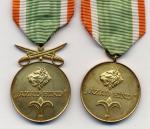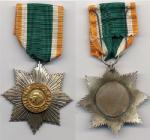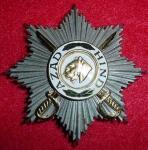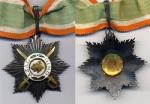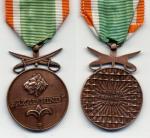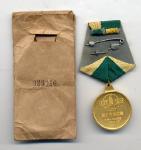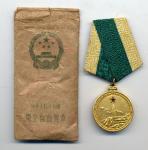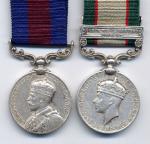-
Posts
14,343 -
Joined
-
Last visited
-
Days Won
28
Content Type
Profiles
Forums
Blogs
Gallery
Events
Store
Everything posted by Ed_Haynes
-
Always glad to help . . .
-
What is it? Picked it up in Delhi back in the 1970s. For a whopping Rs. 5. Bronze with a minimal silver wash.
-
Sanad-i-Bahaduri / Certificate of Bravery Awarded for low levels of bravery not warranting the award of a higher decoration. In essence, a mention in dispatches award. Sources are unclear whether this is a certificate alone, with or without a representative ribbon, or whether it was even issued at all. Awarded to those who rendered meritorious service in the field but fell short of qualifying for a decoration. While it appears to have been a sort of mention-in-dispatches award, some sources suggest some sort of medal accompanied the award. Known to have been awarded 12 times in Southeast Asia. To understand the award better, a sample recipient would 2/Lieutenant Dura Badadur: ?In March [1944?], in the Central Sector [of the Burma front] 2/Lt. Dura Bahadur was sent to contact a Gurkha unit of the British army. Dura Bahadur, risking his life, reached the Gurkha unit, through the enemy lines, and talked with them for half an hour. ?The Gurkha unit promised to do propaganda for the I.N.A. in other Gurkha units. 2/Lt. Dura Bahadur also told them that I.N.A. wants to capture that position and that it is an important point for the I.N.A. from the military standpoint. ?The same day, a few hours later another I.N.A. officer met those people and they surrendered that place according to the instructions of the I.N.A. officers.?
-
Tamgha-i-Azadi / Medal of Freedom Established in 1942. Awarded to all soldiers in the Indian Legion who had served for a year and a half in the unit. The medal is sometimes seen without swords, but this seems to be a fantasy fraudulent postwar restrike. It is estimated that only about three hundred of these decorations were manufactured in Europe; South-East Asian manufacturing and award has not been established. This is a restrike from original dies by Rudolf Souval of Vienna.
-
Tamgha-i-Shartu Nash / Medal for Destroying the Enemy Not much is known about this award. It was established (date unknown) by Bose after he was in Southeast Asia. Awarded to members of the Indian National Army or to civilians for the killing or capture of a British or American officer or enlisted man under conditions where individual bravery and initiative were involved. This appears to be the only Free Indian award distinctive to the Asia Theater. The award came in two classes: first class, for those members of the I.N.A. who exhibit conspicuous gallantry and devotion to duty in killing or capturing alive any British or American officer or other rank, either in single combat or in group fighting, where qualities if individual initiative and bravery come into play; second class, for those members of the I.N.A. who kill or capture alive any British or American officer or other rank, either in single combat or in group fighting, where qualities of individual initiative and bravery come into play. To understand the award better, sample recipients would the awards in the second class to Havildar Pir Mohammed and Havildar Hakim Ali: ?In the Arakan Sector [of Burma], Hav. Pir Mohd. And Hav. Hakim Ali, along with other men, were sent on patrol duty on February 5 [1944?]. On the way they came across a small unit of the 30th Indian Cavalry. Our patrol tried hard to persuade this unit to join the Azad Hind Fauj [= Indian National Army], but as they were under command of a British N.C.O., they did not respond. Upon this Hav. Pir Mohd. and Hav. Hakim Ali fired at them with Tommy guns and killed a British officer and a soldier. The enemy unit who was on patrol took to his heels.? No specimens of the award have been observed or reported.
-
Tamgha-i-Bahaduri / Medal of Bravery Established in 1942. The medal with swords was awarded for bravery, while the medal without swords was awarded for distinguished service to the Indian Legion or to the Free Indian Government. This decoration carried with it an annual stipend of Rs. 150 when awarded with swords. It is estimated that only about three hundred of each division these decorations were manufactured in Europe; South-East Asian manufacturing has not been established. Known to have been awarded 21 times in Southeast Asia. To understand the award better, a sample recipient would be Naik Sultan Singh (presumably, an award with swords, though the account does not specify this): ?During military work in the central sector [of Burma], Naik Sultan Singh preached the British Indian Army in a very able way. But one day, he was arrested by the enemy and he was handed over to a British Indian Coy. ?He convinced the Indian Commander of that Coy. About our I.N.A. and Independence movement in such a way, that next day, when the soldiers of this unit became inclined towards I.N.A. not only Sultant Singh came [to] our rank but he also brought four men, who were placed as guards on him. In addition to this, that Coy. Commander (Subadar) and his Coy. started propaganda work in British Army for the I.N.A.? This is a restrike from original dies by Rudolf Souval of Vienna. The obverse of both the "swords" and "no swords" medals is shown. The reverse is the same as the Shaheed-i-Bharat, above.
-
b]Vir-i-Hind / Hero of India Established in 1942. Awarded to soldiers in the Indian Legion or Indian National Army or civilians for acts of bravery (with swords) or distinguished service (without swords). This decoration carried with it an annual stipend of Rs. 200 when awarded with swords. It is estimated that only about one hundred of these decorations were manufactured in Europe; South-East Asian manufacturing has not been established. Known to have been awarded 11 times in Southeast Asia. To understand the award better, a sample recipient would be S.O. Gurbachan Singh (who was, presumably, awarded the decoration with swords, though the description of his deed does not indicate this): In 1944 ?by the end of May S.O. Gurbachan Singh was going in a boat with some Burmese boatmen to a certain place in Northern Burma. ?At some sound in the river, the enemy by chance opened fire and a bullet struck him just below his knee. One of the boatmen was also injured and the other two having lost their senses left rowing. ?Thirteen American soldiers fell upon the Sub-Officer to arrest him. S.O. Gurbachan Singh plunged into water and lying in concealment behind the boat, began to fire with his pistol. He fatally injured two of the enemy. All his four fingers with which he was resting on the boat got injured, but in spite of that he reloaded his pistol and opened fire again. Just then a bullet crushing his pistol went through the palm of his right hand injuring further his face and brow. ?Still he kept up his courage. With his wounded hand he shifted the boat slightly to the left and with this act saved the life of the two boatmen. After this, when he rowed across to the left bank, he discovered three dead bodies of the enemy soldiers ? the rest having fled.? For this deed, S.O. Gurbachan Singh was also awarded the Tamgha-i-Shatru Nash, first class. Illustrated here is an award without swords (obviously).
-
Sardar-i-Jang / War Leader Established 1942, although there is no sound evidence of awards prior to 1944. Awarded to soldiers in the Indian Legion or Indian National Army or civilians, already in possession of the Vir-i-Hind medal for additional or ongoing acts of bravery (with swords) or distinguished service (without swords). In this sense, the award was generally patterned on the German Iron Cross. There is good evidence that, at least in this case, the European and Asian awards differed substantially. The Southeast Asian variety existed in two classes and it is unclear how these relate ? if at all ? to the structure of the European award. This decoration carried with it an annual stipend of Rs. 250 when awarded with swords. It is estimated that only about one hundred of these decorations were manufactured in Europe; Southeast Asian manufacturing has not been established. Known to have been awarded 12 times in Southeast Asia. To understand the award better, a sample recipient would be Major Pritam Singh (presumably awarded the medal with swords, though the citation does not specify this): ?Major Pritam Singh was commanding one unit of the A.H.F. [Azad Hind Fauj = Indian National Army] in Central Sector [of Burma]. This unit had instructions to penetrate the enemy positions and reconnoiter the enemy. He organized his unit and went on his errand early in May [1944?]. ?When Major Pritam Singh and his party reached near their objective, the enemy opened fire on them with machine-guns and mortars. Not caring for the fire, they marched forward and with loud should of ?Chalo Delhi? [roughly, ?On to Delhi?] charged the enemy. After fulfilling the duty, with which he was entrusted, he ordered his men to retreat. But it was not an easy job to escape from so heavy fire. With a marvelous strategy, Major Pritam Singh was successful in bringing back his unit, with a very little loss. He also inflicted losses on the enemy.?
-
Sher-i-Hind / Tiger of India Established 1942, though the first documented award came only in 1944. Awarded to soldiers in the Indian Legion or Indian National Army or civilians, already in possession of the Sardar-i-Jang medal for additional or ongoing acts of bravery (with swords) or distinguished service (without swords). In this sense, the award was generally patterned on the German Iron Cross. This decoration carried with it an annual stipend of Rs. 300 when awarded with swords. It is estimated that only about one hundred of these decorations were manufactured in Europe; South-East Asian manufacturing has not been established. To understand the award better, a sample recipient would Naik Kehar Singh (presumably an award with swords, but the citation does not specify this): ?On the 18th of May 1944, a unit of the I.N.A. was picqueting a hill in the central sector of the Indo-Burma frontier. Of those on duty, Naik Kehar Singh was one. On an early morning the enemy made an unprecedented pre-planned attack on our picquet. ?One of our comrades, who was working a light machine-gun against the enemy was fatally wounded by enemy fire. He signaled to his comrades to come and occupy his machine-gun. But the man who was to relieve him had already been shot dead by enemy fire. Naik Kehar Singh was witnessing all this from a short distance. He made a spontaneous decision. ?The enemy was firing uninterruptedly. But caring not for his own safety, he rushed through the pouring bullets to occupy the machine gun post. By the time he reached the post, the enemy had approached him to as close as ten yards. With a smile on his lips, Kehar Singh picked up the machine gun and resting it against his hip opened fire on the enemy who were shooting at him with a tommy gun. ?Neglecting the enemy fire, Naik Kehar Singh went on working his own machine gun, so much that the enemy had to retreat. At this he put the machine gun in position and went on firing to push the enemy back to complete retreat.? The medal ? as well as the others ? was also awarded to German (and, one presumes, Japanese) officers and others involved with the Indian Legion and Indian National Army. For example, the famous late German phalerist Dr. K.-G. Kleitmann was awarded the Sher-i-Hind with swords. It is estimated that only perhaps twenty-five Sher-i-Hind medals were awarded, including two awards for Southeast Asia.
-
Shaheed-i-Bharat / Martyr of India Established in 1942. Awarded posthumously to all Indian soldiers who gave their lives in the armed struggle for Indian independence, 1942-45. The medal is sometime seen without swords, and this is almost certainly a fantasy manufacture. It is estimated that only about three hundred of these decorations were manufactured in Europe; South-East Asian manufacturing has not been established. Known to have been awarded 4 times in Southeast Asia. This is a restrike from original dies by Rudolf Souval of Vienna.
-
Whihe sometimes viewed as "Nazi" awards these are not, these are alliesd awards of the Provisional Government of Azad Hind [Free India] (PGAH). Established in Germany by Netaji Subhas Chandra Bose, the PGAH represents the sole pre-1947 issuance of awards by Independent India. (Well, there are a couple of medals issued by Congress for various Satyagraha campaigns, but....) Will post PGAH awards here. Ed
-
-
Cased. Numbered 04673. No document or attribution Awarded to junior officers for service in the Revolutionary War during the War of Liberation Period (3 September 1945 to 30 June 1950). In effect, this is the medal for the final phase of the Civil War.
-
Reverse scan. None of these scans are very good (or very large). Will dig it out if you need more info and better scans. The Hohenzollernsche Denk?nze f?r K?mpfer von 1848/49 is, of course, flipped. The mounting on that one has gone "wonky". But as the mount is original, I am unwilling to "muscle" it around too much. Ed
-
-
2- Liberation Merit Medal / Jie Fang Jiang Zhang - 39260 Awarded for service in the Revolutionary War during the War of Liberation Period (3 September 1945 to 30 June 1950). In effect, this is the medal for the final phase of the Civil War.
-
-
Yes, Rick. Numbers match! Medal/envelope/book all match up. 1- Independence and Freedom Merit Medal / Du Li Zhi Yu Jiang Zhang - 029010 Awarded for service in the Revolutionary War during the Japanese Resistance War Period (7 July 1937 to 2 September 1945). In effect, this is the medal for WWII.
-

EK 1914 3/4 size 1813 EK2...opinions.
Ed_Haynes replied to Dave B's topic in Germany: All Eras: The Iron Cross
Will have to dig it out and check . . . . -

Pre-1947 Indian Gallantry groups
Ed_Haynes replied to Ed_Haynes's topic in Great Britain: Orders, Gallantry, Campaign Medals
Enough for now . . . !! -

Pre-1947 Indian Gallantry groups
Ed_Haynes replied to Ed_Haynes's topic in Great Britain: Orders, Gallantry, Campaign Medals
78105 Rifleman Asarsing Limbu, MM, 1/7th Gurkha Rifles Intersestingly, he was a Gorkha from Sikkim (Ganju Lama VC, MM -- and a Buddhist -- also of 7GR was another of the Gorkha diaspora living in Sikkim). 1- Military Medal "78105 RFMN. ASARSING LIMBU GR" Award published in London Gazette 2 August 1945, p. 3860. Recommendation from WO 373/40: "On the night of 22/23 March 1945 at MEIKTILA a strong enemy force later estimated at two Bns, with two guns attacked the battalion perimeter. "The fiercest part of this attack, which was not only supported by the two guns at point blank range but also by MMG, LMG and mortar fire, was located in the area of the main road. No 78105 Rifleman Asarsing Limbu was defending the slit trench nearest the road and opposite our MMG post when the enemy made a sudden rush covered by very heavy fire in attempt to overrun the MMG position. Some of the enemy succeeded in penetrating the wire. Riflman Asarsing Limbi with complete disregard for danger left his slit trench and attacked them with grenades and his bayonet, killing three and driving the rest back. "He then returned to his trench and replenished his supply of grenades. Four times he drove the enemy out and accounted for about fifteen to twenty of the enemy. Early in the morning he volunteered to go forward with a clearing party and moving well ahead killed one sniper and engaged a second whom he also killed after being wounded by a grenade. This riflemans dash and determination to kill the enemy was an example and inspiration to all." He was also wounded B II p. 519 s.l. 504 - 78105 Asarsingh Limbu 23 March 1945, Burma IV. Bate & Smith, p. 437: 78150 Rfn. Limbu, A., Burma, LG 2 August 1945, p. 3960 General Slim witnessed this deed, see his Defeat into Victory. 2- 1939-45 Star "78105 RFN. ASARSING LIMBU, 7 G.R." 3- Burma Star "78105 RFN. ASARSING LIMBU, 7 G.R." 4- The War Medal, 1939-45 "78105 RFN. ASARSING LIMBU, 7 G.R." -

Pre-1947 Indian Gallantry groups
Ed_Haynes replied to Ed_Haynes's topic in Great Britain: Orders, Gallantry, Campaign Medals
It is a bit hard to know how to classify this group. Is it "pre-1947 gallantry" or is he a "British Gurkha"? Let me just show it and let you decide. IO 7480 Subadar-Major Tikajit Pun, Bahadur, OBI, IDSM, 3/2 Gurkha Rifles born 1905, West Nepal Enlisted 25 November 1922 Jemadar 18 July 1937 Subadar 1 October 1940 MBE shown by Oct 1946 IAL - OBI (Bahadur), IDSM opted for British service 1 January 1948 Lt (GCO) 1 January 1948 Capt (GCO) 11 November 1953 retired 14 February 1961 died 29 October 1977, British Gurkha Centre, Paklihawa Later Honorary Major (GQO). His son: Major Lalbahadur Pun, MC, 1/2 GR. From the regimental newsletter, 1961: "Tikajit?s name was international news in 1953 when SS Sangola ran aground in the Hooghly river. The ship, which was carrying some 1,500 passengers, was soon in danger of breaking up and sinking. The Gurkhas under Tikajit?s command quickly organised the disembarkation of the passengers without any panic or loss of life. For this admirable action by Tikajit, the Chairman of BISN Company presented the Brigade of Gurkhas with three silver bugles - The Sangola Bugles." 1- The Most Excellent Order of the British Empire, 2nd type, member Shown by Oct 1946 IAL. 2- Order of British India, second class 21 June 1947, actually not presented until October 1951. Though shown naked -- unribboned -- here, it is now clothed. An old scan, sorry. 3- Indian Distinguished Service Medal, George VI - SUBDR. TIKAJIT PUN, 3-2 G. R. Chhina, p. 236: IO 7480 Subadar Tikajit Pun, 3/2 GR - Hindu Gurkha, Nagli, Mallajha, 4000 Parbat, Bahunga, No. 4 West, Nepal - IDSM Burma/EFI 232-H/1944 - The IDSM was awarded for distinguished services during the First Chindit Expedition behind enemy occupied lines in Burma, March and April 1943. The IDSM was notified in the London Gazette of 19th October, 1944. Recommendation from WO 373/34: "Subedar Tikajit Pun was the senior Gurkha officer of a column which was forced through a breakdown in communications and the consequent lack of rations to return across the Chindwin under particularly arduous conditions. His energy and devotion to duty were unfailing and on all occasions he set a superb example of cheerfulness in great adversity. It was largely due to his exemplary conduct that his men, despite hunger and exhaustion, regained their base as a formed body and without casualties. "He displayed the same qualities of leadership during this difficult march as he had previously shown under fire and was throughout of the greatest assistance to his column commander." 4- India General Service Medal, 1908-35, George V, 1st variety - WAZIRISTAN 1921-24 - 678 RFMN. TIKAJIT PUN, 1-2 G. R. 5- India General Service Medal, 1936-39 - NORTH WEST FRONTIER 1936-37 - JEMDR. TIKAJIT PUN, 1-2 G.R. 6- 1939-45 Star - unnamed 7- Burma Star - unnamed 8- The War Medal, 1939-45 - unnamed 9- The India Service Medal, 1939-45 - unnamed 10- The General Service Medal, 1918-64, George VI (4th obverse, 1949-52) ? MALAYA - CAPT. TIKAJIT PUN S.B. M.B.E. O.B.I. I.D.S.M. 2 G.R. Note that the naming is incorrect, in that it shows him as S.B. (?Sardar Bahadur?) rather than just ?Bahadur?, which is all he?d be with an OBI2. 11- The Indian Independence Medal, 1947 - 388433, CPT. TIKAJIT PUN OBI MBE IDSM SB G.R. Note that the naming is incorrect, in that it shows him as S.B. (?Sardar Bahadur?) rather than just ?Bahadur?, which is all he?d be with an OBI2. -

Pre-1947 Indian Gallantry groups
Ed_Haynes replied to Ed_Haynes's topic in Great Britain: Orders, Gallantry, Campaign Medals
Subadar Mohd. Sher, IDSM, 3/1st Punjab Regiment Punjabi Muslim, Sudhan-Barul, Sudhonti, Poonch State Enrolled - 19 January 1924 Jemadar - 12 March 1941 (in the context of this action?) Subadar - ??? (War Substantive Subadar) IAL Jan 1942 War Services Sup., p. 382, shows NO additional war services 1- Indian Distinguished Service Medal, George VI - JEMDR. MOHD. SHER, 3-1 PUNJAB R. Chhina, p. 201 - I.D.S.M. - LG 30 December 1941, p. 7339 - 151-H/1941, for Italian East Africa (only one to the regiment for that theater). Reccomendation in WO 373/29 - Company Havildar Major (now Jemadar) Mohammed Sher, 3/1st Punjab Regiment, 5th Indian Infantry Brigade, 4th Indian Division: ?On 10 February 1941 during the attack on HOGS BACK this N.C.O. showed great coolness and disregard for personal safety in moving about (in his functions as Company Havildar Major) and assisting his Coy. Commander. "On 11 Feb 1941 during the action on BRIGS PEAK Coy Hav Major MOHAMMED SHER again showed outstanding bravery and coolness. He moved freely amongst the forward sections encouraging Section commanders. When the enemy pressed home his attack Coy Hav Major MOHAMMED SHER was present in assisting the defence and freely exposed himself in throwing bombs at the enemy. "11 March 1941 on Pt 1710 when the Coy had suffered 4 killed and 3 wounded by mortar fire, Coy Hav Major MOHAMMED SHER showed disregard for personal safety by carrying back wounded men to safety whilst under mortar fire. "This N.C.O's name was submitted for bravery at TUMMAR WEST." 5 Feb 1941, 3/1st Punjab placed under command of 11th Indian Infantry Brigade, and shifted from Agordat to the area of kilometers 109-110 by 1715 hours. At 1600 hours on the 6th, the 3/1st went into combat in support of the 1st Rajputana Rifles and bore heavy Italian counter-attacks, depecially against "D" company. Sanchil and Brigg's Peak taken, but lost again. 10 Feb 1941, 3/1st Punjab sent against Brigg's Peak at 1500 hours: "B" coy to Hog's Back, "A" coy to Saddle, "C" coy to the center of Brigg's Peak, and "D" coy to the right feature of Brigg's Peak - captured, by Italian counterattack by 1715 - consolidated all except the right efature by close of the day - 11 Feb, "D" coy counterattacked the right feature at 0530 and took it - held positions under continuous shellfire - 2300 hours on 11 Feb a major Italian counterattack drove 3/1st off Brigg's Peak by 0230 with 11 killed and 40 wounded - 3/1st to 5th Indian Infantry Brigade. Back to forward line on 15/16 February 1941. By mid-March 1941, to serve in reserve in attack by 4th Sikhs on Mt. Samanna, to secure poritions on the line Mt.Jepio-Pt. 1572-Pt. 1710- Pt. 1702. Recipient was commissioned Jemadar on 12th March 1941. 2- 1939-45 Star - unnamed 3- Africa Star - unnamed 4- Italy Star - unnamed 5- Defence Medal - unnamed 6- WWII War Medal, MiD - unnamed 7- France: Croix de Guerre, 1939, bronze palm The CdG is shown in Qureshi's regimental history, most probably for actions at Kissoue, outside of Damascus, Syria, where he was wounded on 13 June 1941. Five CdGs were awarded to the regiment for this campaign, but only two to Indians. The Regimental History records him as being wounded at Kissoue, outside Damascus on 13th June 1941. The History also records the Award of the Croix de Guerre (for Syria) and also confirms the M.I.D. (for the same action?). An nice W.W.2 ?Three Decorations? group. As it is a (post-1947) "Pakistani" group, all but the IDSM are unnamed, there is some concern about "restoration", but the source is solid, so . . . ? -

Pre-1947 Indian Gallantry groups
Ed_Haynes replied to Ed_Haynes's topic in Great Britain: Orders, Gallantry, Campaign Medals
I put this badly broken group as "pre-1947", though, if intact, it would be "post-1947". Where are the missing medals?!? IO-47757 Jemadar Sanbahadur Gurung, VrC, MC, 2/8th Gurkha Rifles Born - 18 October 1915, v. Niranganpur, Dehra Dun, UP Father - Sh Man Bahadur Religion - Hindu Enrolled - 18 Oct 1932 Jemadar - 9 February 1944 1- Military Cross, George VI, first variety, 1945 MC - Italy, London Gazette, 13 December 1945, p. 6076. Recommendation (WO 373/14): "On 14 Apr 45 Jem Sanbahadur led his pl in an assault against the CORRECHIO canal in order to est a firm base for the crossing of the SILLARO river. Although pinned by intense enemy mortaring and spandau fire the pl eventually reached and captured an enemy strong point with the loss of seven men wounded. At the same time th enemy had sustained considerable cas incl two killed whilst in addition 4 prisoners were taken. Barely had he secured his objective before the enemy in superior numbers began to inflitrate around his flanks. "Calling for mortar fire which he personally directed he succeeded in forcing the enemy to withdraw. The remainder of the coy moving up behind Jam Sanbahadur was thus able to cross the canal and firmly est itself. "The next day another Bn, the 2/10 [GR] successfully assaulted and crossed the SILLARO river. The success of this important action was partly due to the brilliant exploit of Jem Sanbahadur. "Subsequently, on 19 Apr, this VCO led his pl in the night attack on the river GAIANA. He was amongst the first to cross the river in the face of hy spandau fire and grenading which caused considerable cas in his pl. Undaunted and with exemplary courage Jem Sanbahadur quickly re-organised his rections before assaulting the second objective which he did successfully. Despite hy enemy shelling and mortaring this gallant platoon commander continued to move from one section to another encouraging his men. "During the whole of the operations from 9 Apr to 2 May Jem Sanbahadur constantly displayed superb dash and gallantry, outstsnding leadership a disregard of danger worthy of the highest praise." 2- India General Service Medal, 1936-39 - NORTH WEST FRONTIER 1937-39 - 8869 RFN. SUNBAHADUR GURUNG, 2-8 G R 3- The General Service Medal, 1918-64, George VI (4th obverse, 1949-52) - PALESTINE 1945-48 - 47757 JEMDR. SANBAHADUR GURUNG, 2-8 G.R. Later awarded VrC for Jammu and Kashmir (15 Nov 1948); Gandhi I, p. 370 (Gandhi II, p. 466): "Subedar San Bahadur Gurung, commanding a platoon at Leh, was ordered to recapture Lasirmou at a height of 18,270 ft. On the night of 29 July 1948, he appeared in the rear of the enemy position after a strenuous night of 13 hrs. in extrenmely difficult terrain. His successful attack resulted in the rout of the enemy who left behind many dead and one prisoner. "In October, he worked as second in command of guerillas behind the enemy lines, destroying an enemy 3.7-inch howitzer at Basgo. Again in November he went 70 miles behind the enemy lines and destroyed a big enemy ammunition column at Lamayuru. "On all these occasions he showed outstanding bravery, devotion to duty and leadership." -

Pre-1947 Indian Gallantry groups
Ed_Haynes replied to Ed_Haynes's topic in Great Britain: Orders, Gallantry, Campaign Medals
6809 Rifleman Dholi Gurung, IDSM, 2/5th Royal Gurkha Rifles 1- Indian Distinguished Service Medal, George V, 2nd variety - 6809 RFM DHOLI GURUNG, 2-5 R.G.R. Chhina, p. 239: 6809 Rifleman Dholi Gurung, 2/5th Royal Gurkha Rifles, March 1937, GO 324/1937 (5 IDSMs in this GO), N.W. Frontier Confirmed as for the defence of Damdil piquet, one of the great Gorkha actions of the 20th century. 2- India General Service Medal, 1936-39 - NORTH WEST FRONTIER 1936-37 - 6809 RFM DHOLI GURUNG, 2-5 G.R. Gaylor (p. 233): ". . . the only regiment to receive the between-wars North-West Frontier battle honours" = "North West Frontier 1936-39" This is almost certainly his complete entitlement.




